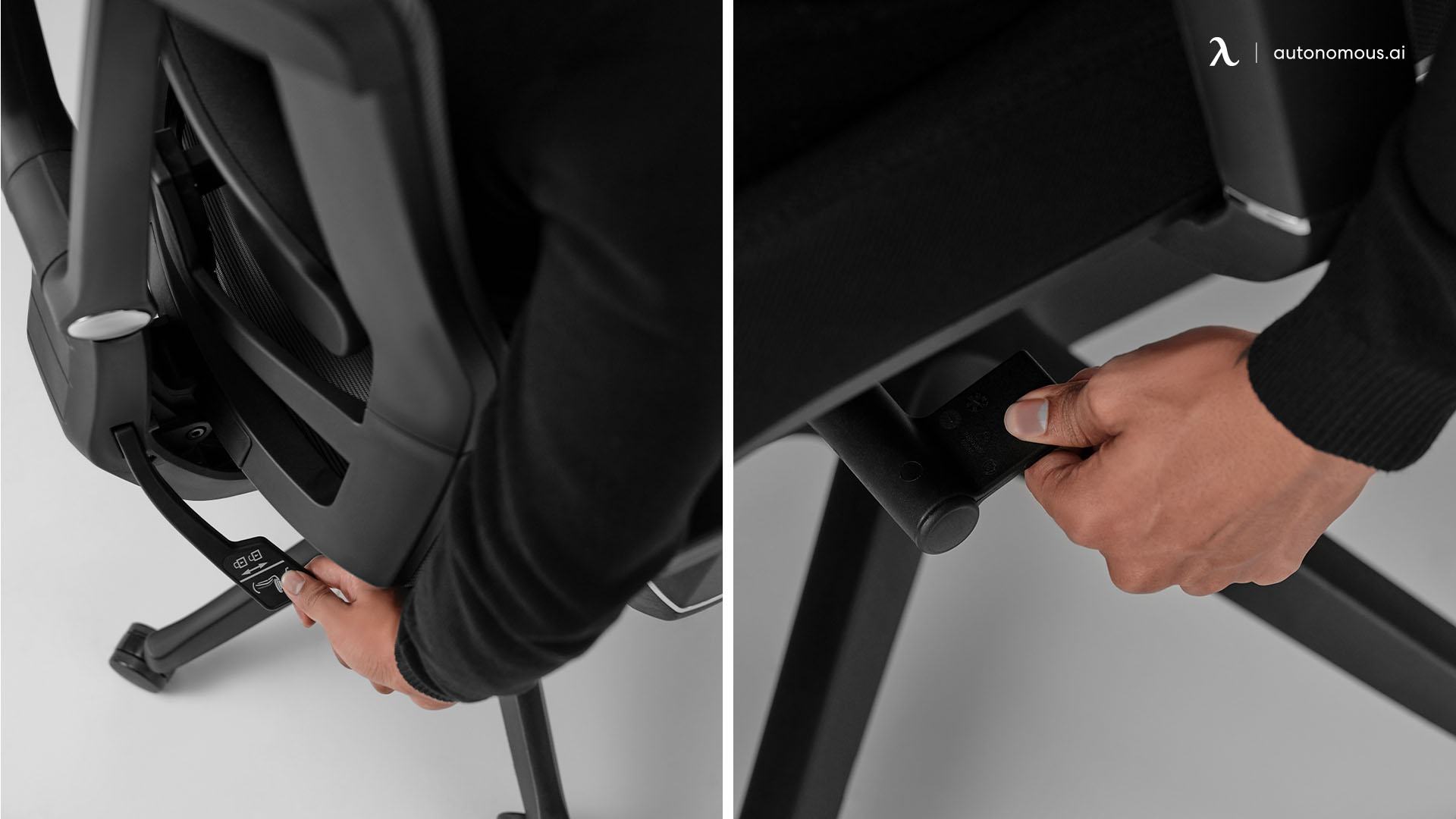Physical Address
304 North Cardinal St.
Dorchester Center, MA 02124
Physical Address
304 North Cardinal St.
Dorchester Center, MA 02124

Explore the importance of backrest height adjustment in maintaining good posture and preventing lower back pain. Learn how to adjust your chair's backrest for optimal comfort and productivity.

In the dynamic realm of office ergonomics, the adjustment of backrest height stands as a pivotal element, transcending mere functionality. This vital adjustment significantly influences your comfort, directly impacting your posture and overall health. Our comprehensive guide on backrest height adjustments delves deep into the mechanics and recent research, offering invaluable insights. Whether you’re spending long hours in a home office or a bustling corporate environment, understanding these principles is key to boosting your comfort and productivity.
Why It’s Crucial: Adjusting the backrest height isn’t merely a convenience; it’s essential for aligning your spine correctly. This alignment is the cornerstone of both comfort and long-term health when you’re seated for extended periods.
Health Payoffs: A well-adjusted backrest supports the natural lumbar curve of your lower back, significantly reducing the likelihood of back pain and other posture-related ailments.
The Lumbar Factor: The lumbar curve, or the inward curve of your lower back, needs precise support. A misaligned backrest—whether too high or too low—can result in poor posture and subsequent discomfort.
The Fit Factor: The ability to customize your backrest height ensures that the chair adapts to you, not the other way around. This adaptability is key to maintaining proper posture and minimizing health risks.

Achieving the optimal backrest height adjustment on your office chair is a seamless process. Follow these easy steps to ensure you’re seated comfortably and your spine is properly supported. If you’re looking for a detailed walkthrough on adjusting your chair for maximum comfort, our ergonomic chair buying guide provides a wealth of information.
Remember, everyone’s body is different, so what works for one person may not work for another. It’s important to adjust the chair to your own comfort and not to a predetermined standard.


Delving into the science behind backrest height adjustment reveals its roots in ergonomics – the study of efficiency in work environments. When adjusted correctly, the backrest height not only supports the spine’s natural curve, preventing back pain, but also enhances overall musculoskeletal health. For more insights into ergonomic principles and their application in office settings, our article on choosing the right ergonomic office chair offers comprehensive guidance.
Here’s how it works:
Why Speed Matters: Recent studies have shown that the speed at which you adjust your backrest can have a substantial impact on your comfort level. Slow adjustments may lead to muscle strain, while too quick adjustments can cause abrupt shifts in posture.
The Ergonomics of Adjustment: Understanding the biomechanics involved in backrest height adjustment can offer insights into achieving optimal comfort. Research indicates that the angle and speed of adjustment should be in harmony with the natural curvature of your spine.
Body Type: Your height and weight significantly influence the ideal backrest height. For instance, taller individuals may require a higher backrest for adequate lumbar support.
Chair Design: The type of chair you use also plays a role. Ergonomic chairs often provide a wider range of adjustments compared to traditional office chairs.
Workspace Environment: Don’t overlook the setup of your workspace. The height of your desk and the placement of your computer screen can also affect how you should adjust your backrest.
The Importance of Speed: While most guides focus on the ‘how-to’ of backrest adjustment, the speed at which you make these adjustments is often overlooked. Yet, it’s a crucial factor that can affect your comfort and even your health.
Comfort vs. Speed: Striking the right balance between quick adjustments and comfort can be challenging. Too fast, and you risk a jarring experience; too slow, and you may strain your muscles.
Optimal Speed Guidelines: Research suggests that a moderate speed of adjustment, aligned with your natural movements, can offer the best of both worlds—comfort and efficiency.
While adjusting the backrest height seems straightforward, common errors can undermine its effectiveness. Avoiding these pitfalls is crucial for maintaining spinal health and comfort. For a deeper understanding of ergonomic adjustments and to explore various chair options, consider reading our detailed article on the best ergonomic office chairs, which provides a broader perspective on office chair features and ergonomics.
Setting the backrest too high or too low: If the backrest is set too high, it can push the head forward and strain the neck. If it’s set too low, it can cause the user to slouch, which can strain the lower back.
Not adjusting the backrest at all: Some people may not realize that their chair’s backrest height is adjustable, or they may not know how to adjust it. As a result, they may end up sitting in a chair that doesn’t properly support their back, which can lead to discomfort and back pain.
Ignoring discomfort: If you feel discomfort while sitting, it’s a sign that something needs to be adjusted. Ignoring this discomfort can lead to chronic pain and other health problems down the line.
There are many different types of office chairs on the market, each with their own set of features. When it comes to backrest height adjustment, here are a few things to consider:
Read More >> Ergonomic Chair Buying Guide: Essential Tips for Beginners
Each individual has a unique body type, which necessitates a personalized approach to ergonomic chair adjustments. Whether you’re tall, short, or have specific postural needs, finding the right backrest height and chair settings is crucial for comfort and health. Our extensive guide on best office chairs for tall people and best office chair for short people offers tailored advice for these varied requirements.
Your work environment, whether a compact home office or a spacious corporate setting, influences how you should adjust your chair. The right adjustments in different contexts can enhance productivity and reduce discomfort. For insights on optimizing your workspace, check out our guide on compact home office setups.
Different office chair models offer varied levels of adjustability. From the traditional tilt tension to advanced lumbar support features, understanding these variations is key. Our article on comparing top ergonomic office chairs for remote workers provides a comprehensive comparison to help you make an informed decision.
While ergonomics is vital, aesthetics also play a significant role in chair selection. Balancing functionality with style contributes to a more pleasant and motivating workspace. Explore our range of stylish yet comfortable options in best stylish ergonomic desk chairs.
In summary, backrest height adjustment is an indispensable feature of any office chair, crucial for tailoring the chair to your physical needs. It supports the spine’s natural curvature and is instrumental in preventing back pain. Gaining knowledge on how to adjust and what to seek in an office chair enhances your comfort and productivity, be it in a home setting or a conventional office. Don’t miss this essential feature on your next office chair purchase – your back will surely appreciate it. Discover more about optimal seating solutions in our comprehensive guide to home office setups.
To find the correct backrest height, sit in your chair with your feet flat on the floor. Adjust the backrest so that it comfortably supports the natural curve of your lower back, typically around waist level.
Yes, properly adjusting your office chair, especially the backrest height, can significantly reduce back pain. It ensures that your spine is correctly aligned and supported, minimizing strain on your back muscles.
Absolutely! There are ergonomic chairs designed with adjustable features to accommodate different body types. Check out our guides for tall and short individuals for specific recommendations.
It’s advisable to review and adjust your chair settings every few months or whenever you feel discomfort. This ensures continued support and comfort as your body or work habits change.
For a home office, consider a chair with adjustable backrest height, lumbar support, and a comfortable seat. Also, consider the chair’s size and aesthetics to ensure it fits well in your home workspace. Our home office setup guide offers more insights.